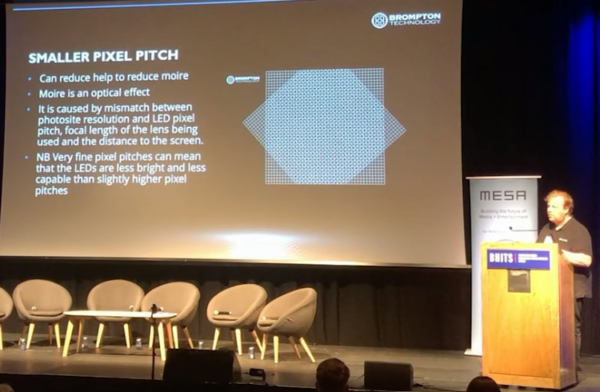M+E Connections

British HITS: What to Consider When Buying or Renting LED Panels
Story Highlights
As virtual production becomes more accessible for all content creators, it is increasingly important to get beyond all the jargon and acronyms being thrown around.
Hugh Davies Webb, product manager at Brompton Technology, discussed what integrators, producers and studios should take into account when considering an LED wall or upgrading their current facility during the session “What to Consider When Purchasing LED Panels” at the Nov. 15 British Hollywood Innovation & Transformation Summit (HITS) event in London.
The session helped set the stage for the virtual production discussions throughout the day at the event.
Despite the title of the session, Davies Webb said the details he was offering “applies to renting” LED panels also.
“One of the things that people are faced with, especially if you’re not a technician – perhaps you’re involved with production or you’re a producer and you’re on the more business end of things – [is the belief LEDs are] all black squares really and they look kind of the same,” he said. But he noted: “That’s not necessarily the truth.”
When selecting an LED panel, “getting this decision right with virtual production is really pretty important – and if you don’t get it right, then it’s going to cost someone quite a lot of money,” he warned.
“The reason for that,” he explained, is that “LED is a relatively new technology in the wonderful world of filmmaking and what people could get away with LED panels for live events, rock concerts, Imax screens and things like that, you can’t get away with on set because cameras are very, very particular.”
Therefore, he said: “My advice, straight off the bat … is that there’s no substitute for getting a camera out and testing your particular requirements ahead of time. So if you’ve got a friendly rental company or acquiring some LED panels for a particular volume and for a particular set of circumstances, particular content or whatever, there’s no substitute for getting some panels, putting them up, putting them in a studio somewhere, getting the camera that you’re going to use with the settings that you’re going to use with it, and some of the content that you’re planning to use and filming it and seeing what the problems are.”
That, he pointed out, “means doing some moves if you’re using cranes and dollies, moving those around because, [with] LED, there are some issues when you start moving cameras.”
 Because “not all LED screens are made equal … doing your homework ahead of time will pay dividends and hopefully prevent you from making some expensive mistakes,” he told attendees.
Because “not all LED screens are made equal … doing your homework ahead of time will pay dividends and hopefully prevent you from making some expensive mistakes,” he told attendees.
One “very subtle thing that most people don’t appreciate is that LED walls, LED panels have a viewing angle…. And the viewing angle is how many degrees vertically and horizontally the LED panel can be viewed at before it starts to shift color,” he also pointed out, noting: “This is an important thing if you are using cranes or dollies…. As you move out of the viewing angle, then the color will shift. And so that is something that is very important to get right.”
Scan Line Multiplexing
Davies Webb moved on to a subject he called “a bit more geeky”: scan line multiplexing, something he said “not many people outside of the LED industry actually know anything about – and, generally, LED manufacturers avoid talking to you about.”
Modern LED systems use LED driver integrated circuits (ICs), which he said generate pulse width modulation (PWM). LEDs making up a screen are digitally dimmed using PWM. And the LED driver ICs drive PWM to the LEDs, he noted.
“Instead of having the dedicated chip output for each pixel, the outputs are sort of shared across several” LEDS, typically on different lines, Davies Webb said.
The number of lines each driver output controls is known as the scan mux ratio, he pointed out. For example, a 16:1 scan mux ratio means each driver IC output drives 16 different lines, he noted. The driver IC controls the electronics that switch which of these lines of pixels it is driving very rapidly, he said, adding persistence of vision means the eye builds up a flicker-free complete image.
A scan-mux ratio equal to or below 11:1 is preferable for virtual productions, he went on to say.
However, he cautioned attendees to be aware that camera, source and LED processors must be “genlocked” together. Generator locking is a common technique in which the video output of a source is used to synchronize other picture sources together.
A lower scan-mux ratio can often mean higher maximum frame rate, he added.
High Definition Processing
Moving on to high definition processing specifically, he said proper calibration allows for color accurate workflows and correctly implements standard dynamic range (SDR) and high dynamic range (HDR) electro-optical transfer function (EOTF).
“But there aren’t many calibration systems on the market other than ours that allow for absolute color accuracy and implements” SDR and HDR EOTF, he said.
Genlock is essential (source, camera and processing) from input to LED refresh need to be genlocked together, he stressed. Ten-bit/12-bit processing is required for HDR and wide color gamut, while Brompton’s ShutterSync feature allows the timing of the LED refresh to be tuned to camera settings, he noted.
Smaller Pixel Pitch
Moving on to smaller pixel pitch, he said: “The other thing that’s kind of obvious but that people run into all the time [is that] smaller pixel pitch LEDs tend to avoid the problem of moire,” an optical effect that he noted is “famous with LED screens that use TV cameras or film cameras.”
Moire is caused by mismatch between photosite resolution and LED pixel pitch, focal length of the lens being used and the distance to the screen.
Very fine pixel pitches, meanwhile, could mean the LEDs are less bright and less capable than slightly higher pixel pitches, he noted.
Higher Frame Rates
Higher frame rates are “also becoming an important thing,” he said, adding: “Before the pandemic, 60 hertz was more than acceptable for use with LED walls. But nowadays you might want to use multiples of the camera refresh rate.”
A new feature called frame rate multiplication, meanwhile, “allows you to multiply the frame rate of the LED screen,” he said.
Panels supporting higher frame rates are “more versatile and have more headroom for features like extended bit depth,” according to Davies Webb.
Frame rate multiplication and frame remapping require high frame rates, he said. High frame rate panels can be useful for eSports and the highest frame rate panels can support up to 250Hz, he added.
To download the presentation slides, click here.
To view the entire session, click here.
The British Hollywood Innovation & Transformation Summit, held in conjunction with the EIDR Annual Participant Meeting, was sponsored by Whip Media, GeoComply, Perforce, Signiant, and EIDR, was programmed under the guidance of the content advisors of the Hollywood IT Society, and was produced by MESA and the Hollywood IT Society (HITS).









